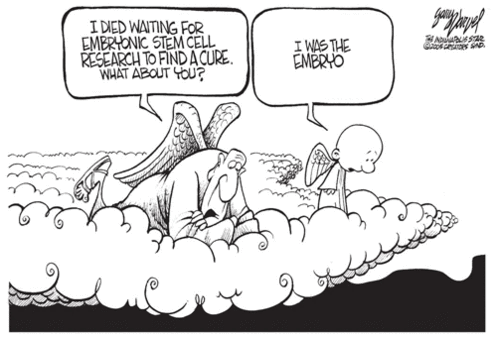
Stem Cells: The Building Blocks of Life
Ethical Debate: Do the Benefits Outweight the Costs?
Harvesting human embryonic stem cells is an invasive procedure and has raised a lot of controversy since its introduction in the late 20th century. Opponents claim that the use of human embryonic stem cells requires the destruction of human embryos, resulting in the intentional and unjust killing of human beings. The moral implications behind this debate has greatly influenced federal decisions regarding funding for stem cell research. An underlying question raised by this controversy is: when does a human being begin to exist? Also, is the destruction of a human embryo justified when juxtaposed with the cures it can provide for other human beings?
The introduction of induced pluripotent stem cells (iPSCs) in 2006 has somewhat alleviated the ethical issues presented by the use of embryonic stem cells. iPSCs are adult cells that are genetically modified to function as pluripotent stem cells and are very similar to embryonic stem cells. If iPSCs can be modified to reach the same potential as human embryonic stem cells, then much of the stem cell controversy can be resolved. However, iPSCs are a relatively new discovery that still needs refining. Whether iPSCs are truly equivalent to human embryonic cells is still under debate.

Cloning
Therapeutic cloning is a method in which scientists harvest pluripotent stem cells directly from a patient, utilizing a method that is remarkably similar to that of reproductive cloning (a process that has a very different purpose from therapeutic cloning and produces a genetically cloned individuals). One technique used in therapeutic cloning is somatic cell nuclear transfer (SCNT), the same technique that was used to clone Dolly the Sheep. This technique involves the transplant of a nucleus from the cell of a patient’s body into an healthy egg that was stripped of its own genetic material. The resulting embryo becomes the source of embryonic stem cells that are genetically compatible with the donor of the nucleus, which avoids the common problem of immunorejection. However, SCNT raises several controversies seeing as it requires the destruction of human embryos. Furthermore, it is closely related to cloning, which is a highly debated topic itself. Though therapeutic cloning offers great potential in regenerative medicine and has a very different purpose than reproductive cloning, the destruction of human embryos remains a prominent factor in the debate.
